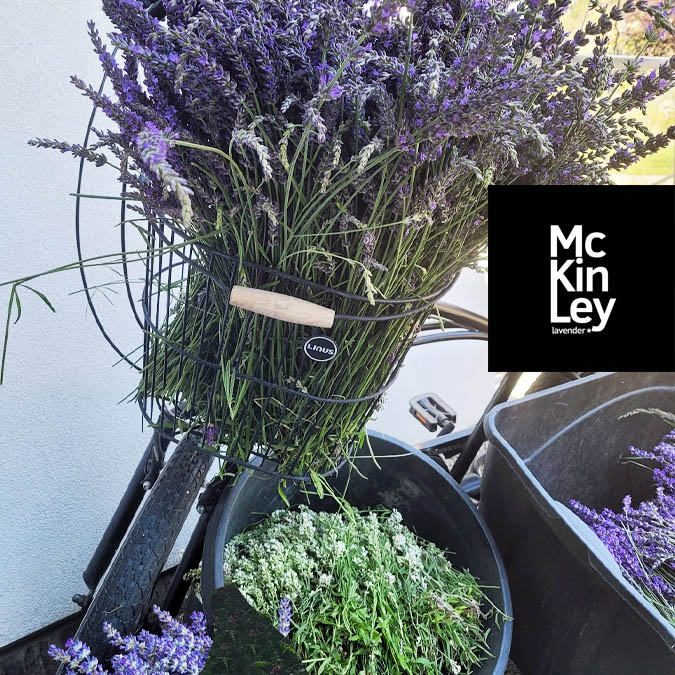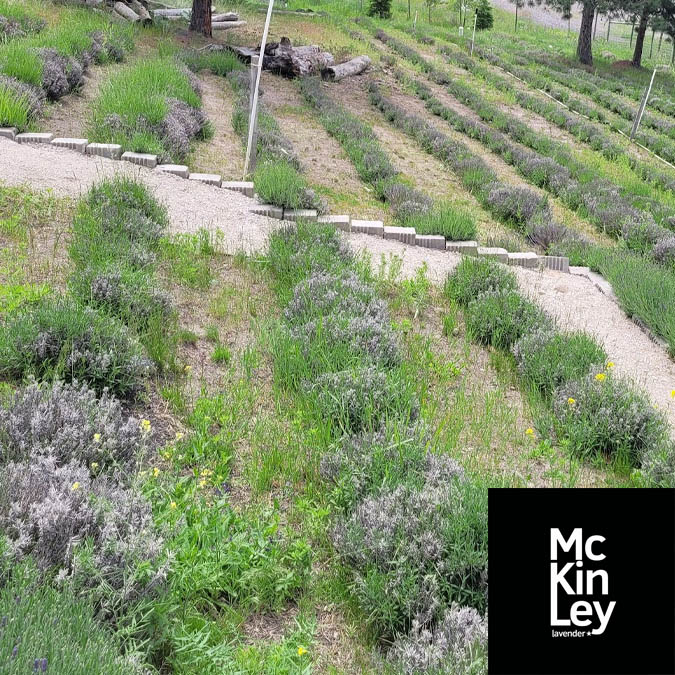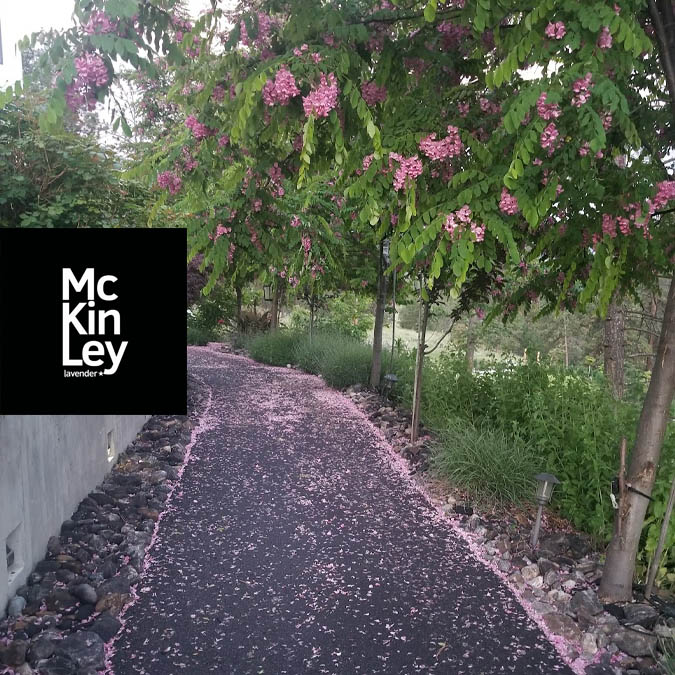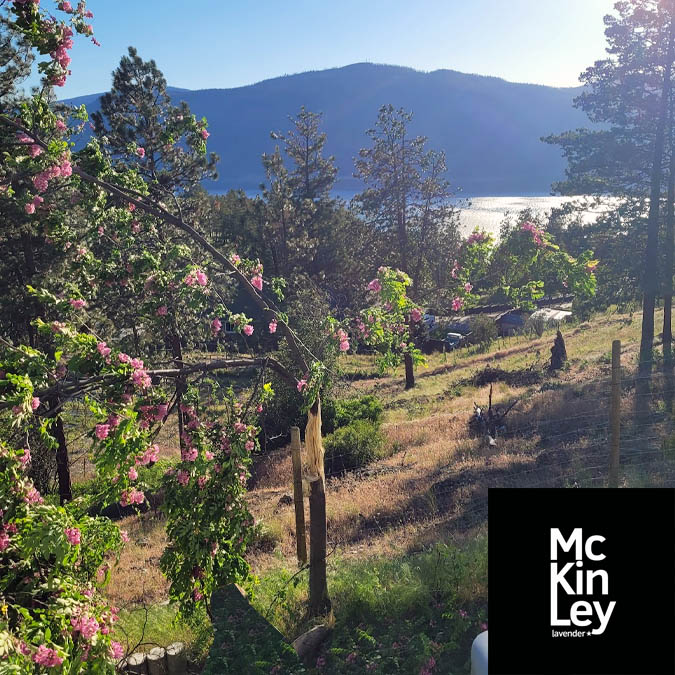
The July lavender harvest is underway at McKinley Lavender Farm in Kelowna, BC, Canada.
Where does the time go? It seems like only yesterday that we were complaining about last July, and here we are, all set to complain again 😉 Kidding. We love what we get to do. But it’s hot. The fires are starting to close in around us, and we’d be lying if we said last summer and winter didn’t impact our plant health this season. Well, we won’t know for sure, but suffice it to say the fire and temperatures of last summer combined with the extreme week of cold we experienced this winter, killed off some of our more mature and sensitive crops. I’m talking about you French lavender!
Keep reading for an update on what’s growing, and what we lost in plant life this year! Get a closer look at this year’s lavender harvest!
Let’s get the bad news out of the way first.

Our French Phenomenal suffered the worst of it. We’ve been pulling up dead French plants this week. We’ve all seen dead lavender. It’s in many a city garden boulevard and even more apartment front walks. There isn’t a city I’ve visited where I haven’t noticed a dead, or dying plant needing help. We tend to leave our dead-looking lavender plants for at least one full season to see if we can nurse them back to health.
In most cases, we are successful. Pruning away the dead wood will leave you with a plant that looks like Edward Scissorhands attacked it. But, in the long run, this is a great way to see if you can encourage new growth. I would say we average 50% success using this method on our French plants. If we’re talking English varietals, we cut those right back to the nitty gritty end, right at the roots. 9 times out of 10 your English varieties will come back from the roots if there are still signs of life. Like any dead plant in your garden, if you can easily move it around or pull it right out with a tug then it’s dead, dead. We know the frustration of losing a plant after years of enjoying it, all too well.

Love Hate for Robinia.
That brings me to one of our hardest losses of the season so far. One of our 10-year-old Purple Robe Locusts, or the Robinia pseudoacacia fully succumbed to a windstorm in early July. 10 years ago, we planted six of them around the perimeter of our main walkway. We’ve since added so many more that I’ve lost count. That’s the love part of planting Locusts. If you aren’t familiar with the Purple Robe Locust then I would encourage you not to fall too hard for them. They will break your heart. They are invasive, they snap easily, and they’re an absolute mess in the late spring and fall. But wow. When they’re in bloom they are something to behold. Especially because we have so many on the property. It’s a whispy, bubblegum explosion come late June on the farm and I can never get enough of it.
As it is with every windstorm that whips up off Okanagan Lake, we watched out the windows with reluctant hope that this one would pass by quickly and leave us unscathed. Unfortunately, it got more and more violent with each gust and we knew early on that we weren’t going to get through this storm without some damage. And then the unthinkable. Our beautiful tree which we planted so many years ago and was one of the remaining untouched locusts on the farm took the brunt of a wind gust and split right down the middle. Shearing off 10 years of dappled shade growth in an instant. With a loud crack the tree we had strategically planted in front of our kitchen window to block the sun, was gone.

The good news is we have a great view of Okanagan Lake from our kitchen window again. The bad news? I’ll probably have to invest in some blinds while we wait for the tree to grow back from the roots.
An Epic Lavender Harvest Followed By No Okanagan Stone Fruit in 2024.
Everyone has likely heard the news about the unprecedented cold snap and how it affected the peach and nectarine crops throughout the Okanagan. We have a few of each fruit tree on our property and we should be picking juicy peaches right now. There’s none. If you haven’t already felt the impact in the grocery stores you can be assured that the prices for these two crops will be sky high. It’s disappointing for sure, but some crops thrive each year and some crops do poorly. It’s important to diversify. Our annual veggies are doing great. Tomatoes, peppers, herbs, and more are all thriving in their raised planter beds.
Our Largest Lavender Harvest Ever.

Without question, this season has produced more lavender for us than ever before. It was a slow rainy start to spring with June seeing unrelenting precipitation for weeks. As soon as July hit, the temperatures hit peak Okanagan and have consistently remained in the high 30s (96f+) ever since. This has cultivated a recipe for peak lavender production. We began harvesting our White Ellagance plants first, moving to our English Hidcote, Deep Purple Lavance, and Munstead. Normally we would harvest Super Blue at the same time as the Hidcote Blue. Super would also be cut well before any of our French. For some reason, the Super is extra slow to pop this year. In fact, we’ve almost cut all of our French lavender and still have 50% of the Super left in the field. Normally the French isn’t ready until the end of July or early August. However, while things are a little out of order, there is plenty more to cut on each plant than in seasons past. The plants that survived have been producing beautiful stems and with the bonus of super dry heat, we’ve already got dry stock being boxed daily.
Maybe, this lavender harvest will be the first year we don’t fully sell out of dried lavender 😉
Around the lavender farm, other than harvesting, we’re mostly in maintenance mode. We haven’t added any new gardens to the farm this year. There are still two areas left for us to plant and at some point, we might address the old soccer pitch. We’ve been renovating several of the older areas that have been around for 10 years. As always, lots of weeding, tree and shrub pruning, soil remediation, and some removal and disposal of plants that didn’t survive the season.
There’s always something to weed, move, cut, or pick.
This will be a great year if you’re looking to buy dried lavender for your markets, products, or crafting!
